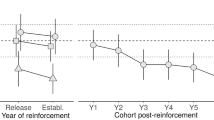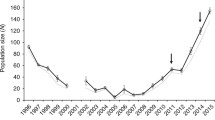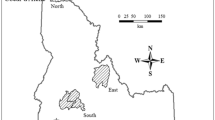Abstract
Management practices often aim to increase the level of gene flow by either: introducing animals from captive breeding programs, translocating animals from abundant areas, or increasing the chance of animals dispersing between populations by creating habitat corridors. These practices provide opportunity for the hybrid offspring of introduced and resident animals to experience either increased fitness (hybrid vigor) or decreased fitness (hybrid breakdown). There is very little quantitative data available to adequately assess whether hybridization is likely to be beneficial or detrimental to populations managed in these ways. Using Drosophila melanogaster populations, we conducted two experiments that simulate the common management practices of translocation and wildlife habitat corridors. We monitored the frequency and magnitude of hybrid vigor and hybrid breakdown in F1 hybrids to assess the relative risks and benefits to populations and also monitored net productivity (number of adults produced from controlled crosses) to assess whether the populations were stable or in decline. In the translocation experiment, we observed instances of both significant hybrid vigor and hybrid breakdown, both occurring at a frequency of 9%. In the habitat corridor experiments, populations with moderate to high dispersal (1–4% per generation) did not develop significant hybrid vigor or hybrid breakdown. However, of the populations experiencing low dispersal (0.25% per generation) for 34 generations, 6% displayed significant hybrid vigor and 6% displayed significant hybrid breakdown. These results suggest that in first generation hybrids there may be limited opportunity to utilize hybrid vigor as a tool to increase the short-term viability of populations because there is an equal likelihood of encountering hybrid breakdown that may drive the population into further decline. However, our results apply only to populations of moderate size (N = 50; N e = 14.3) in the absence of deliberate consanguineous mating. Lastly, we observed that net productivity was positively correlated with dispersal rate, suggesting that initial F1 declines in fitness may be temporary and that it is preferable to maintain high levels of selectable variation via induced dispersal to assist the long-term survival of vulnerable populations.




Similar content being viewed by others
References
Ackermann M, Bijlsma R, James AC, Partridge L, Zwaan BJ, Stearns SC (2001) Effects of assay conditions in life history experiments with Drosophila melanogaster. J Evol Biol 14:199–209
Backus VL, Bryant EH, Hughes CR, Meffert LM (1995) Effect of migration or inbreeding followed by selection on low-founder-number populations: implications for captive breeding programs. Conserv Biol 9:1216–1224
Ball SJ, Adams M, Possingham HP, Keller MA (2000) The genetic contribution of single male immigrants to small, inbred populations: a laboratory study using Drosophila melanogaster. Heredity 84:677–684
Beier P, Noss RF (1998) Do habitat corridors provide connectivity? Conserv Biol 12:1241–1252
Birchler JA, Auger DL, Riddle NC (2003) In search of the molecular basis of heterosis. Plant Cell 15:2236–2239
Boussy IA, Kidwell MG (1987) The P-M hybrid dysgenesis cline in eastern Australian Drosophila melanogaster: discrete P, Q and M regions are nearly contiguous. Genetics 115:737–745
Bryant EH, Backus VL, Clark ME, Reed DH (1999) Experimental tests of captive breeding for endangered species. Conserv Biol 13:1487–1496
Crow JF (1948) Alternative hypotheses of hybrid vigor. Genetics 33:477–487
Devlin B, Roeder K, Wasserman L (2003) False discovery or missed discovery? Heredity 91:537–538
Dickerson GE (1969) Experimental approaches in utilizing breed resources. Anim Breed Abstr 37:191–202
Edmands S (1999) Heterosis and outbreeding depression in interpopulation crosses spanning a wide range of divergence. Evolution 53:1757–1768
Edmands S (2006) Between a rock and a hard place: evaluating the relative risks of inbreeding and outbreeding for conservation and management. Mol Ecol 16:463–475
Ehiobu NG, Goddard ME (1990a) Heterosis in crosses between geographically separated populations of Drosophila melanogaster. Theor Appl Genet 80:569–575
Ehiobu NG, Goddard ME (1990b) Heterosis in F2 generations of Drosophila melanogaster. Aust J Zool 37:609–616
England PR, Briscoe DA, Frankham R (1996) Microsatellite polymorphisms in a wild population of Drosophila melanogaster. Genet Res 67:285–290
Falconer DS, Mackay TFC (1996) Introduction to quantitative genetics. Longman Group Ltd, Essex
Ferreira AGA, Amos W (2006) Inbreeding depression and multiple regions showing heterozygote advantage in Drosophila melanogaster exposed to stress. Mol Ecol 15:3885–3893
Fischer M, Matthies D (1997) Mating structure and inbreeding and outbreeding depression in the rare plant Gentianella germanica (Gentianaceae). Am J Bot 84:1685–1692
Fishman L, Willis J (2001) Evidence for Dobshansky-Muller incompatibilities contributing to the sterility of hybrids between Mimulus guttatus and M. nasutus. Evolution 55:1932–1942
Frankel OH (1983) The place of management in conservation. In: Schonewald-Cox CM, Chambers SM, MacBryde B, Thomas L (eds) Genetics and conservation: a reference for managing wild animal and plant populations. Benjamin/Cummings, California, pp 1–14
Gandon S, Capowiez Y, Dubois Y, Michalakis Y, Olivieri I (1996) Local adaptation and gene-for-gene coevolution in a metapopulation model. Proc R Soc Lond B 263:1003–1009
Gilligan DM, Briscoe DA, Frankham R (2005) Comparative losses of quantitative and molecular genetic variation in finite populations of Drosophila melanogaster. Genet Res Cam 85:47–55
Gunn M (2003) The use of microsatellites as a surrogate for quantitative trait variation. Ph.D. Thesis, University of New South Wales, Sydney
Henle K, Lindenmayer DB, Margules CR, Saunders DA, Wissel C (2004) Species survival in fragmented landscapes: where are we now? Biodivers Conserv 13:1–8
Hess GR (1994) Conservation corridors and contagious disease: a cautionary note. Conserv Biol 8:256–262
Holleley CE (2007) Economical high-throughput DNA extraction procedure in 96-well format for Drosophila tissue. Dros Inf Serv 90:137–138
Holleley CE (2009) Testing hypotheses in molecular ecology: genetic exchange and hybrid performance. Ph.D. Thesis, University of New South Wales, Sydney
Holleley CE, Sherwin WB (2007) Two robust multiplex PCR reactions for high-throughput microsatellite genotyping in Drosophila melanogaster. Dros Inf Serv 90:140–144
Holleley CE, Hocking AD, Schubert TL, Whitehead MR (2008) Control of Penicillium roqueforti (Thom) infection in cultures of Drosophila melanogaster (Meigen) (Drosophilidae: Diptera). Aust J Entomol 47:149–152
Ingvarsson PK (2002) Conservation biology: lone wolf to the rescue. Nature 420:472
Kidwell MG, Novy JB (1979) Hybrid dysgenesis in Drosophila melanogaster: sterility resulting from gonadal dysgenesis in the P-M system. Genetics 92:1127–1140
Loebel DA, Nurthen RK, Frankham R, Briscoe DA, Craven D (1992) Modeling problems in conservation genetics using captive Drosophila populations: Consequences of equalizing founder representation. Zoo Biol 11:319–332
Lozovskaya ER, Scheinker VS, Evgen’ev MB (1990) A hybrid dysgenesis syndrome in Drosophila virilis. Genetics 126:619–623
Marr AB, Keller LF, Arcese P (2002) Heterosis and outbreeding depression in descendants of natural immigrants to an inbred population of song sparrows (Melospiza melodia). Evolution 56:131–142
Miller B, Ralls K, Reading RP, Scott JM, Estes J (1999) Biological and technical considerations of carnivore translocation: a review. Anim Conserv 2:59–68
Moll RH, Lonnquist JH, Fortuna JV, Johnson EC (1965) The relationship of heterosis and genetic divergence in maize. Genetics 52:139–144
Oettler G, Burger H, Melchinger AE (2003) Heterosis and combining ability for grain yield and other agronomic traits in winter triticale. Plant Breed 122:318–321
Pimm SL, Dollar L, Bass OL Jr (2006) The genetic rescue of the Florida panther. Anim Conserv 9:115–122
Reed DH (2004) Extinction risk in fragmented habitats. Anim Conserv 7:181–191
Reed DH (2005) Relationship between population size and fitness. Conserv Biol 19:563–568
Rhode JM, Cruzan MB (2005) Contributions of heterosis and epistasis to hybrid fitness. Am Nat 166:E124–E139
Sagvik J, Uller T, Olsson M (2005) Outbreeding depression in the common frog, Rana temporaria. Conserv Genet 6:205–211
Schierup MH, Christiansen FB (1995) Inbreeding depression and outbreeding depression in plants. Heredity 77:461–468
Seddon P, Armstrong DP, Maloney RF (2007) Developing the science of reintroduction biology. Conserv Biol 21:303–312
Spielman D, Frankham R (1992) Modeling problems in conservation genetics using captive Drosophila populations: improvement of reproductive fitness due to immigration of one individual into small partially inbred populations. Zoo Biol 11:343–351
Swindell WR, Bouzat JL (2006) Gene flow and adaptive potential in Drosophila melanogaster. Conserv Genet 7:79–89
Templeton AR (1986) Coadaptation and outbreeding depression. In: Soulé ME (ed) Conservation biology: the science of scarcity and diversity. Sinauer, Sunderland, pp 105–116
Templeton AR (2001) Disrupting evolutionary processes: the effect of habitat fragmentation on collared lizards in the Missouri Ozarks. Proc Nat Acad Sci USA 98:5426–5432
Templeton AR, Neuwald JL, Brazeal H, Robertson RJ (2007) Restoring demographic processes in translocated populations: The case of the collared lizards in the Missouri Ozarks. Israel J Ecol Evol 53:179–196
Tilman D, May RM, Lehman CL, Nowak MA (1994) Habitat destruction and the extinction debt. Nature 371:65–66
Turcek FJ (1951) Effect of introduction on two game populations in Czechoslovakia. J Wildlife Manage 15:113–114
Vila C, Sundqvist AK, Flagstad O, Seddon J, Björnerfeldt S, Kojola I, Casulli A, Sand H, Wabakken P, Ellegren H (2002) Rescue of a severely bottlenecked wolf (Canis lupis) population by a single immigrant. Proc R Soc Lond B 270:91–97
Wallace B (1968) Topics in population genetics. Norton and Co, New York
Weir BS, Cockerham CC (1984) Estimating F-statistics for the analysis of population structure. Evolution 38:1358–1370
Westemeier RL, Brawn JD, Simpson S, Esker TL, Jansen RW, Walk JW, Kershner EL, Bouzat JL, Paige KN (1998) Tracking the long-term decline and recovery of an isolated population. Science 282:1695–1698
Whitlock MC (1992) Temporal fluctuations in demographic parameters and the genetic variance among populations. Evolution 46:608–615
Whitlock MC, Ingvarsson PK, Hatfield T (2000) Local drift load and the heterosis of interconnected populations. Heredity 84:452–457
Acknowledgments
We acknowledge L. Tsai, E. Ho and J. Chao for fly culture assistance; O. E. Gaggiotti, A. R. Templeton, J. L. Wang and M. Mariette for comments on the manuscript and the Ramaciotti Centre for Gene Function Analysis for DNA fragment size analysis. This research was supported by Australian Research Council Grant DP0559363 to WBS and RAN.
Author information
Authors and Affiliations
Corresponding author
Electronic supplementary material
Below is the link to the electronic supplementary material.
Rights and permissions
About this article
Cite this article
Holleley, C.E., Nichols, R.A., Whitehead, M.R. et al. Induced dispersal in wildlife management: experimental evaluation of the risk of hybrid breakdown and the benefit of hybrid vigor in the F1 generation. Conserv Genet 12, 31–40 (2011). https://doi.org/10.1007/s10592-009-9984-z
Received:
Accepted:
Published:
Issue Date:
DOI: https://doi.org/10.1007/s10592-009-9984-z




